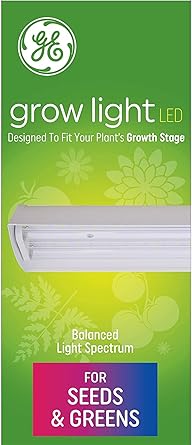If you’re looking to start an indoor garden or grow plants year-round, GE’s LED Grow Light for Indoor Plants might be the perfect solution. This integrated light fixture provides a balanced light spectrum ideal for seed starting, fruit production, and growing greens or herbs. However, before making a purchase, it’s important to consider both the advantages and disadvantages of this product. In this article, we’ll explore the pros and cons of the GE LED Grow Light and answer some frequently asked questions to help you make an informed decision.

Pros of the GE LED Grow Light
Natural Light: The GE grow light bulbs provide a pleasing, natural light temperature that integrates well with any decorative aesthetic, allowing you to showcase your indoor garden without the purple or reddish lighting often associated with grow lights.
Energy-Efficient: These indoor grow lights feature advanced LED technology that uses only 40 watts of energy, making them an energy-efficient choice for your indoor gardening needs.
Low Heat Generation: The low heat generation of these grow lights ensures a suitable temperature for your plants, reducing the risk of heat damage.
Long Lifespan: With a lifespan of up to 25,000 hours, the GE LED Grow Light is a long-lasting investment for your indoor gardening setup.
Balanced Light Spectrum: Each grow light bulb appears as white light to the eye but has a balanced light spectrum that is ideal for tomatoes, leafy greens, and herbs at all growth stages, providing versatility for your indoor garden.
Cons of the GE LED Grow Light
Limited Coverage: The 24-inch light fixture may not provide sufficient coverage for larger indoor gardens or greenhouses, requiring multiple units to cover a larger area.
Potential for Uneven Lighting: Depending on the layout and height of your indoor garden, the light distribution from a single fixture may result in some plants receiving more or less light than others, potentially leading to uneven growth.
Cost: While the GE LED Grow Light is an energy-efficient option, the initial cost of the product may be higher than some traditional grow light options, making it a more significant investment upfront.
Frequently Asked Questions
Can the GE LED Grow Light be used for all types of plants?
While the balanced light spectrum is ideal for tomatoes, leafy greens, and herbs, the GE LED Grow Light may not be suitable for all types of plants. It’s essential to research the specific lighting requirements of the plants you intend to grow to ensure the GE LED Grow Light is a good fit.
How far should the light be from the plants?
The recommended distance between the GE LED Grow Light and your plants varies depending on the size and growth stage of your plants. As a general rule, place the light 12-24 inches above the top of your plants, adjusting the height as your plants grow taller.
How long should the plants be exposed to the GE LED Grow Light?
The optimal duration of light exposure depends on the specific plant species and growth stage. Most plants require 12-18 hours of light per day during the vegetative stage and 12-14 hours during the flowering stage. Consult the specific requirements for your plants to ensure they receive the appropriate amount of light.